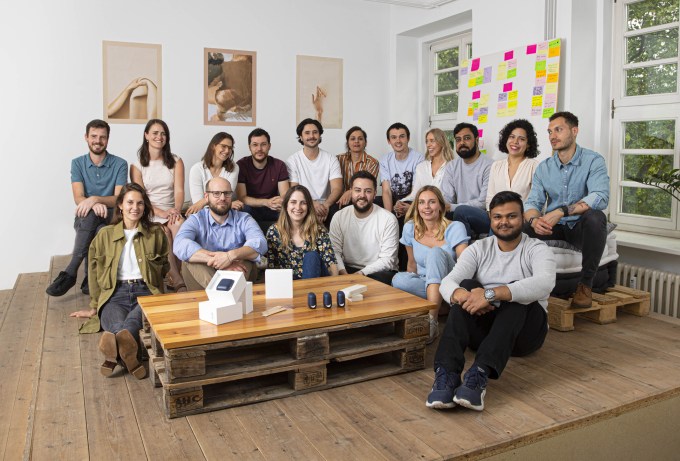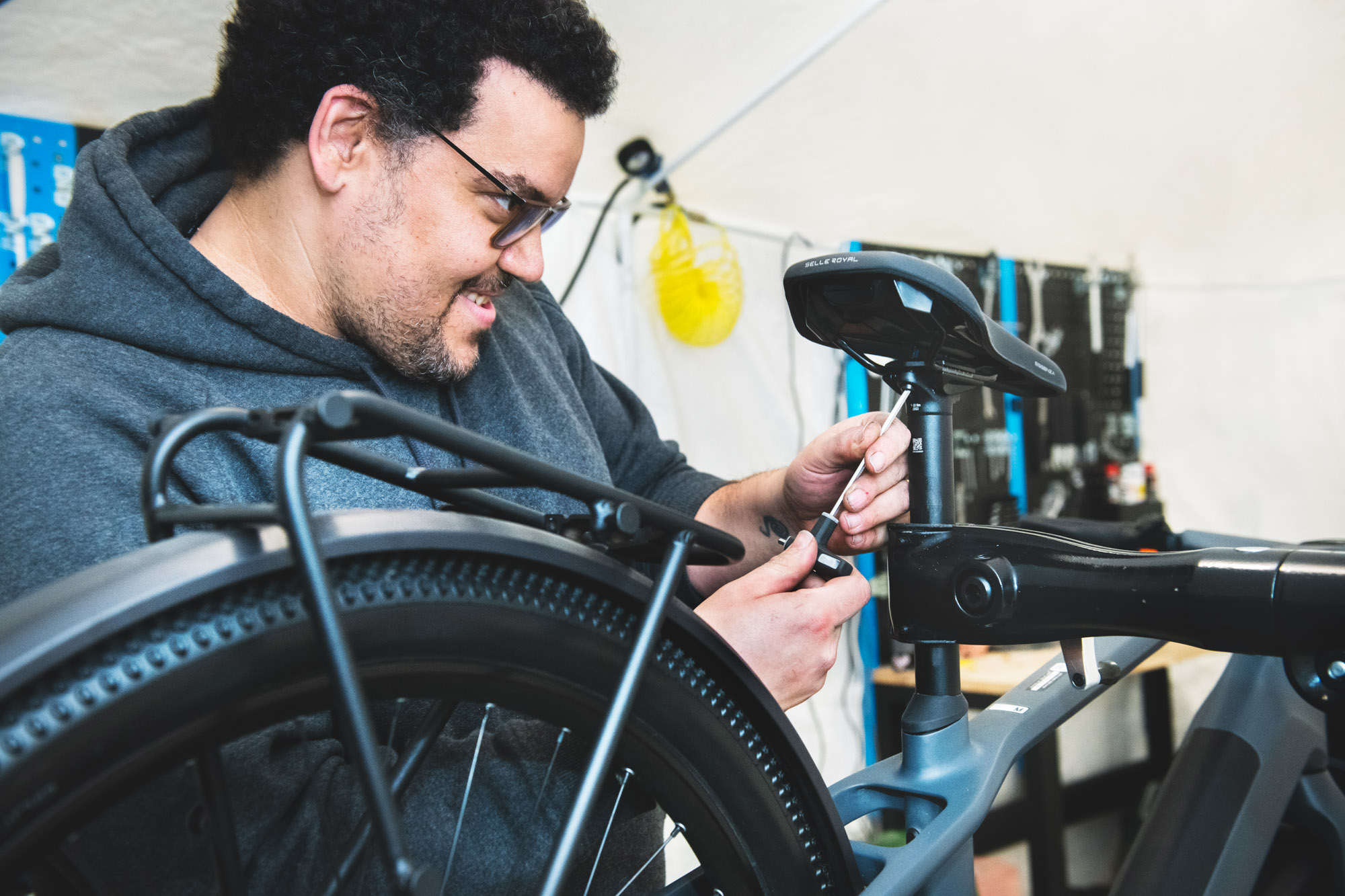It’s been a tough few years for Berlin-based femtech hardware startup Inne which came out of stealth R&D in the fall of 2019, shortly before COVID-19 hit Europe. By January 2020, founder and CEO Eirini Rapti tells us she was busy making final inspections ahead of the launch of its debut product — a connected device it calls a “minilab” for at-home, saliva-based hormone testing to support fertility and cycle tracking — but then, in just a few weeks, the region was plunged into lockdown and everything changed.
Hardware startups are rarely smooth sailing at the best of times. But the coronavirus pandemic created a cascade of new challenges for Rapti and her team around supply chain and logistics — upsetting their careful calculations on unit economics. The pandemic also called a halt to a major piece of research work the startup had lined up with a US university to study its hormone-tracking method for a key contraceptive use-case — a product it had intended to prioritize but could not bring to market ahead of the study which is required to gain regulatory approval.
In a matter of weeks, Inne was forced to freeze its big launch as it tried to figure out how best to move forward — and, indeed, whether it should launch the product at all in such a challengingly reconfigured environment.
“Due to COVID-19 we’ve had to really shift around our plans,” says Rapti, talking to TechCrunch via video chat. “We had loads of unpredicted supply chain issues… There were so many fuck-ups that came up with COVID-19! It’s unbelievable what happened.
“I remember our last interview [in October 2019], I was super optimistic — I’m still very optimistic — sort of really looking forward to get all of our tech out to the world. We were setting up our production line when I spoke to you. We had John Hopkins [research university] agreeing to our contraceptive study. Like, the world was my oyster… And then I came back from a last inspection of the goods coming off the production line in January 2020 and we were hearing about what was happening in China but we were not really conscious of it and then we were so busy with pre-sales and whatever.
“And then of course a month later we didn’t know if we were going to get raw materials from China. We didn’t know if the factories that were working within Europe were going to even be able to have people in the factory. ”
The start of the planned contraception study also kept being postponed, as the US research institution which had agreed to conduct it, pre-pandemic, understandably prioritized work related to COVID-19 itself.
The upshot for Inne was a shock freeze on its best laid plans — plans Rapti had been working towards since 2017 when she founded the business and kicked off R&D to get the at-home hormone testing product to market.
“2020 for me started on this big high — we had our final products, we got our approval [to sell the device in Europe], we are launching pre-sales. I think we had 200 people buy the product and then we kind of had to stop because we didn’t know if we were even able to deliver these 200… This is how bad it was,” she adds.
As well as having shelled out to set up a production line it suddenly had to suspend, Inne had also doubled the size of its team to prepare for scaling. But suddenly the message from the investment world was ‘slow everything down’, recounts Rapti. “So I was like why didn’t you tell me two months ago?!… My whole strategy came crumbling down.”
The supply chain and logistics disruption — some of which has lingered even while pandemic lockdowns have eased — also forced Inne to concentrate most of its effort on the German market in Europe — “because we wanted to contain, as much as possible, the logistical nightmare”, as she puts it.
“Electronic chip shortages of course are affecting everyone… but it’s also as simple as backlog on logistics,” she explains, discussing how COVID-19 has dialled up difficulties for the fledgling hardware business. “Your shipments take longer or your air freight is much more expensive and all of a sudden your price per unit becomes really high — and for a small company like us, for a startup, if you cannot demonstrate your unit economics and your growth what can you demonstrate? And quite frankly I was sitting there for a few months — and I think it was the first time I froze in my career where I felt I have no idea what I will be able to show in the next six months!”
By summer 2020, Rapti was facing a big decision over how to move forward while the business was still mired in uncertainties around supply chain resilience and with no new date on when it would be able to launch contraception as it still hadn’t found a replacement partner to do the study.
Additionally, it was unclear when the startup would be able to raise more funding in such a challenging climate. Yet, given the expanded team Rapti had put in place ahead of the 2020 launch, she needed to consider burn rate — which meant deciding whether she had to let staff go to give the startup the best chance of surviving so much disruption.
The choice boiled down to two options, per Rapti: Either cut everything right back, keeping only a bare minimum of staff to extend the runway and find another, probably European-based institution to carry out the contraceptive study; or reduce cash burn a bit but go ahead and launch the minilab with only fertility and cycle tracking — meaning there could be no user messaging on natural contraception, limiting the product’s utility to (only) women trying to get pregnant or those looking for help with an irregular cycle.
In the event, Rapti went for the second choice — saying she was, above all, keen to keep the team she’d built up. She also saw an opportunity to use a partial launch to at least learn about the market, even though continuing supply chain constraints meant Inne had to limit the number of devices shipped to make sure they could provide the full service to the first buyers (its subscription-based progesterone testing service works with packs of single-use daily testing strips to gather the user’s saliva sample, with testing performed by inserting the moistened strip into the minilab for analysis).
“The first year we could circulate — I think — 500 devices, or very little, without having delays. And I think we closed last year with close to 2,000 customers,” Rapti adds.
Outside Germany, Inne also has some early users in Austria, Switzerland and the U.K. — but the launch has clearly been a very different and more painstaking process than Rapti had envisaged from her high in fall 2019.
Another cloud she may not have expected to see looming on the horizon now is the prospect of the US Supreme Court overturning constitutional protections for abortion in the US — which, followed a leaked opinion on Roe v Wade earlier this month, is already causing consternation over the risks that digital services like period tracking apps could pose to US women if their data can be used to track them or to try to build prosecutions around their reproductive health.
“I’m horrified by what is happening to the US,” says Rapti when asked whether she is concerned about this risk. “The reality is we are not right now in a position where, legislatively wise, someone could ask for this data to be used against women in court — as of today. So what I truly believe is it would be counterproductive to go backwards and, instead of giving women access to and understanding of their own data, to say actually we need to scrap all that because it could be used against them.
“I think this would be really a step backwards. But rather I think what our job is — as female health companies — is to defend the rights of our users and also make the data as anonymous as possible so it cannot be traced back to the actual user.”
Rapti argues there is a clear way to separate profile data that is used for marketing from health data generated by usage of the product — and says Inne’s approach for the latter is currently to use double encryption and split usage data and also where it’s processed (some of which she says happens on the user’s device) so that it’s not all sitting in a single repository which it could be easily ordered to hand over.
But she also says the startup would be prepared to create further protections for user data in response to any changes to the law that threaten women’s rights.
“We need to be legally on top of things and make sure that whenever there is a law that is passed we change our product fast in order to guarantee this anonymity as much as possible,” she tells TechCrunch. “And I would rather we invest in that legal capacity on our side than to say we stay away from having women tracking their data because the government could use it. But I definitely see it as our job. We need to be on top of legislative lobbying, if I can put it that way, and make fast changes to our product in the way that data is structured so that we can protect [our users] as much as possible.”
Series A expansion
Today, Inne has better news: An extension to that $8.8M Series A round it closed back in 2019. It’s taking an addition $10M now so it can stock up on raw materials and retool its production line to unplug any remaining production bottlenecks. The expansion to the Series A is led by DSM Ventures, with Borski Fund and Calm Storm Ventures also participating, along with a number of angels, including Taavet Hinrikus (Wise), Dr Fiona Pathiraja and Rolf Schromgens (Trivago).
But not only that — Rapti says it’s planning to expand its product offering to include another hormone test — for cortisol (aka, the stress hormone; tracking cortisol can be useful for athletic performance, as well as for links to wider women’s health issues).
It is also set to its first steps outside Europe later this summer, via a US partnership with a women’s health brand called Phenology. The tie-up will be exclusively focused on perimenopause — so Inne will be getting a toe in the water in that major market while it waits on regulatory clearance for its digital contractive.
The US partner will offer Inne’s device to a subset of its users as a way to track changes in their hormones during the early stage of the menopause — supplementing the services it offers them, which includes personalized wellness programs and supplements. (Notably, Phenology’s parent, a company called Hologram Sciences, shares an investor with Inne — DSM Ventures, aka the venture arm of Dutch vitamin giant DSM — so you can see the investment synergies at work there.)
“It was clear there was a synergy and a very clear geographical separation also — US and then Europe — and they’re not interested in contraception which I always wanted us to own fully globally,” notes Rapti. “And that’s kind of how, through seeing that Hologram Sciences would actually be a great partner for expanding our use-cases to the US, we decided on DSM Ventures being an investor in this round.”
She confirms Inne has finally been able to get a contraceptive study underway this year with a new partner in Europe, saying she expects the work to be completed around November — paving the way for Inne to be able to launch a contraceptive product in Q1 next year. That will put it into competition with the likes of Natural Cycles‘ basal-temperature based ‘digital contraceptive’ (which got regulatory clearance in Europe back in 2017); and period tracking app Clue’s more recent cycle-tracking system which gained FDA clearance for contraception in March 2021, to name two existing products.
So, demand willing, the pieces needed to scale Inne’s hormone-tracking femtech business do finally look to be slotting into place.
“I think it was the right thing to do,” adds Rapti, returning to her decision to go ahead and launch in the middle of the pandemic — to “see who buys the product” and “connect with the customers” — even if that choice meant delaying the launch of the contraceptive product.

Image credits: Inne
“It took me a long time to find especially the science and data science team that losing them over a crisis like this would have been, in the longer term, the worse ordeal,” she adds. “Because you find scientists, you make them product people and product thinking and then to let them go… It’s our core competence so that’s the first thing that I thought.”
Certainly Inne will face more competition when it finally launches its rival contraception. But that’s not necessarily a bad thing in such a novel space where women must be convinced they can trust new entrants’ methods over more tried and tested products for avoiding pregnancy like the pill and condoms.
Going ahead and launching with just fertility and cycle tracking also, of course, allowed Inne to road-test its team as it switched into commercial operations, serving those early customers. So it had a chance to iron out operational and service wrinkles with a small customer base, ahead of what it hopes will be wider scaling — as it expands both its production capacity and the product’s feature set with the help of the extra Series A funding.
Hormone tracking for the quantified self
So who are Inne’s early adopters? “We attract women who are on the less regular side of the cycle, so either have had several miscarriages or have had hormonal issues or have had very fluctuating cycles. So our data is biased towards irregularity,” says Rapti, also noting that users tend to be computer savvy and active on social media, where it does much of its marketing.
Ages of users range from 18 to mid 50s — but with a “peak” between 28 to 38, per Rapti.
Tracking progesterone means Inne can tell users whether they have ovulated or not — which, in turn, could help them detect a month when they have not ovulated, which (for people seeking to get pregnant) could help them understand challenges they may be having. For others, hormone tracking may be helpful to navigate patterns in an irregular menstrual cycle.
Other femtech products can rely on different approaches to try to predict fertility — such as temperature measurements or algorithmic analysis of cycle tracking data — but, as Rapti puts it, “the beauty of progesterone is it can really tell you has it happened or not”, so it’s offering a binary confirmation.
She says the majority of Inne’s users at present are using it for fertility tracking to help them get pregnant, with a smaller proportion (30% last year; but so far this year it’s getting closer to 40%, per Rapti) using it for cycle tracking to manage irregular periods. But she emphasizes that usage is “fluid” and “a bit of a journey” as women’s needs also change.
“We have two modes in the app: You can choose it either to cycle track, basically, but with hormones or to get pregnant,” she explains, adding: “It is such a fluid journey for a women in our product because the data tells me that some women are starting to track their cycle and then they will change their goal in a couple of months so it looks like maybe they’re preparing or they just came off the pill etc.”
Rapti’s wider vision is for the product to be able to “offer something all the way from the first period to the last period” — which is why she’s so keen to get the contraception product launched (asked if she thinks it’ll be the bigger market she says she’s not sure — but, just in pure numbers terms, there are obviously more women of fertile age seeking to avoid pregnancy than wanting to get pregnant at any given moment); as well as to build out utility elsewhere, such as by expanding into cortisol tracking.
The forthcoming cortisol test will provide users with the ability to understand whether they are going through a prolonged period of stress that has chemically affected their body, per Rapti — which she says may in turn be impacting their fertility or sports performance.
Users will be able to specify whether they want to include cortisol tracking in their Inne subscription and, if so, they will be sent a mix of progesterone and cortisol testing strips. But while the former is typically a daily test (which should be taken within a ~three hour window in the morning), the cortisol test is different; it’s not intended to be taken daily but when it is performed it needs to be done multiple times per day (and then that process repeated at intervals).
“You build the profile daily, with cortisol,” explains Rapti. “You do five measurements in one day and you do them every month for example, or every two weeks. But it’s not about, you know, ‘I do a test today and I do a test tomorrow and I see how my stress is’. No, it’s really that you’re building a chemical profile of your day and then you look at that over a period of time to try and understand if you really are under sustained stress and it has chemically affected your body or not.”
The thinking behind adding a second hormone test is not to address a broader range of users but rather to give women more reasons to get the minilab into their lives, per Rapit, by encouraging them to “trust these hormonal insights”.

Inne founder and CEO, Eirini Rapti (Image credits: Inne)
A major update to the next release of Inne’s app will bring a raft of self-reporting options — around what it’s calling “symptoms and events” — which is intended to help users link their daily activity/feelings with hormonal changes they can track using the product.
“We are launching 41 symptoms and events that people have asked for but which will also help us give more specialist insights because we will correlate them with hormones in the coming months,” she says. “They fall in different categories — about exercise, nutrition, certain things such as headache or migraines which are related to hormones; skin conditions, hydration/dehydration. They go from exercise to lifestyle to food to skin. And different types of body pain.”
“The beauty of being able to do that with hormones is you really see [the chemical change] — the opportunity we have here is we know the chemical role of hormones, can we truly related them to self-reported symptoms? And to what extent can we do that,” she adds, confirming: “It’s a long term correlation project. We didn’t want to start with it because we wanted to make sure that hormonal data were always going to take the center stage so we needed a large data pool first to establish what we’re doing and then try to see if it can correlate.”
Here Inne’s products looks as if it could push into ‘quantified self’ territory — with potential utility overlap with a recent wave of biosensing startups and companies that are seeking to commercialize continuous glucose monitoring (CGM) hardware for a more general health/sports performance use-case (i.e. beyond the management of blood glucose for people with diabetes or prediabetes for which the CGM sensing tech was originally developed). And where there are similar question marks over the wider consumer utility of that sort of biosensing (i.e. whether the average consumer can usefully interpret all this real-time biological feedback).
But one built-in advantage Inne’s approach has vs CGM startups is it’s non-invasive. And a consumer may feel more inclined to try something experimental on the off-chance they could discover a helpful correlation if it only requires them to moisten a some test strips in their mouth a few times a month, rather than — in the case of CGM-based glucose tracking — having to live with a biowearable and its metal filament under the skin of their arm for weeks at a time.
Rapti says Inne’s plan is not to break out a totally separate service around cortisol tracking — although she stresses the test itself does involve a completely different user experience — rather the goal is to serve users who want to gain a deeper understanding of how hormones affect their bodies.
“Instead of selling new strips to a different woman what I’m trying to say is this is going to be your subscription and then you tell us what you’re interested in. And if you’re interested in both stress and cycle tracking or fertility then we will send you every month strips of both and we will instruct you what to do when. So we’re not looking to make upselling with new strips but more deeper hormonal understanding so the price will remain the same. And you’ll just get a combination of strips for that same monthly price,” she says.
“I had so many people in this raise who said oh that would be amazing for men, why don’t you sell it to men! Do you know what, I think it would be amazing for men but how about we wait a minute and just offer it to women!” she adds.
There is clearly lots more Inne could do and add. So an obvious challenge is how to create a clear marketing message around such a multifaceted product?
On that Rapti says they’ve got one big takeaway: Women want to get specific about the benefits — which means finding fora where they can discover the product but also get to ask their own questions.
“It is a very early market. I feel that women know that there’s so much they can learn about their bodies and quite frankly we are giving a new angle where we’re like — hey, look, we should be able to track our hormones because [women] have been excluded from research for all those years and if only we had been included we would have known so much more about medication, our bodies, everything around that. So let’s bridge that gap — that’s our mission. And at the same time they’re like this is great but what exactly can you do for me?” says Rapit.
“So the way we’ve been approaching it — what I can tell you works — is to be very precise on what benefit they can get. And that’s why Instagram and influencer marketing works because women get the chance to ask questions and to really understand if this will serve them or not.”








